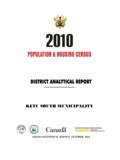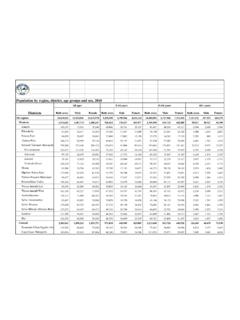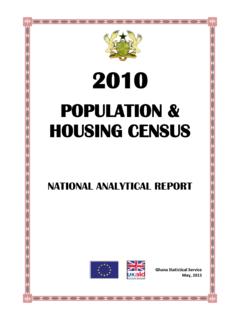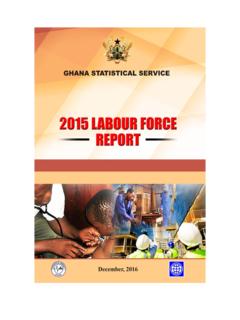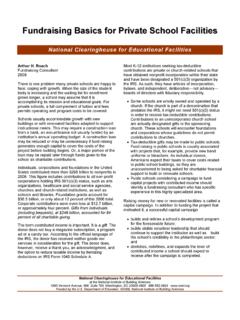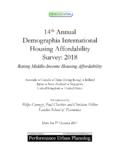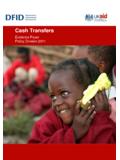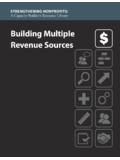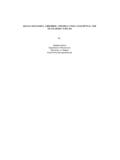Transcription of PREFACE AND ACKNOWLEDGEMENT - statsghana.gov.gh
1 Ii PREFACE AND ACKNOWLEDGEMENT This report presents the main results of the sixth round of the Ghana Living Standards Survey (GLSS6),a nationwide household survey designed to generate information on living conditions in the country. Compared to previous rounds, GLSS6 had two unique features. First, it included a Labour Force Survey module with additional sections on Child Labour, Second, the survey methodology was reviewed to account for the inclusion of additional indicators pertaining to the northern savannah ecological zone, where a major Government initiative, the Savannah Accelerated Development project (SADA) had just been initiated.
2 Other modules administered as part of the survey were the Non-farm Household Enterprises, Household Access to Financial Services and Governance, Peace and Security modules. The survey covered a period of twelve (12) months from 18th October 2012 to 17th October 2013. The data collection instruments and methodology were based on the fifth round with slight modifications. The GLSS6 collected detailed information from households, including their demographic characteristics, education, health, employment and time use, migration and tourism, housing conditions, household agriculture, and access to financial services and asset ownership.
3 The survey also collected information on households perception of governance, peace and security in the country. The data collected has been used to prepare a Poverty Analysis Report. A separate report on the Labour Force Module and a Child Labour Report have also been prepared. Researchers interested in the further analysis of the data are encouraged to apply to the Ghana Statistical Service (GSS) for the use of the data. The methodology of the survey is such that it required substantial human, material and financial resources to successfully implement it. The effort of the GSS was complemented by the substantial support and cooperation received from various stakeholders to make this report possible.
4 The GSS would, therefore, like to acknowledge the varied stakeholder contributions that led to the successful completion of the survey. First, we would like to thank the selected households for their patience and cooperation and for devoting time to the field personnel during the numerous visits and questioning. Our appreciation also goes to the field personnel and data entry officers for the meticulous manner in which they discharged their duties. Many thanks go to the regional and district administrators as well as the traditional rulers and community leaders for the diverse ways in which they provided assistance to the field teams to ensure the success of the fieldwork.
5 The GSS is particularly grateful for the financial support received from the Government of Ghana, the United Kingdom Department for International Development (UK-DFID), UNICEF, UNDP, and the International Labour Office (ILO) for this work. We also acknowledge with gratitude the technical assistance provided by the World Bank throughout the project period. Special thanks go to Ms. Xiao Ye, Mr. Vasco Molini, Mr. Harold Coloumbe and Ms. Rose Mungai for the training and technical advice they provided to staff of the GSS during the preparation of the income and expenditure aggregates. Additionally, we are grateful to Mr.
6 Richard Johnston (UNICEF consultant) for the analysis of the water quality tests on the water samples collected from the households and sources. Our gratitude also go to the ISSER team, especially Professor Felix Asante and Dr. Isaac Osei-Akoto and to Ms. Lynne Henderson of UK-DFID, Mr. Smile Kwawukume of the World iii Bank and Mr. Yacouba Diallo and Mrs. Marie Ndiaye (both of the ILO) for their contributions towards the finalization of this report. Finally, the devoted services of the GLSS6 project personnel, the report writers and all others who have contributed in diverse ways towards the success of the survey and subsequent production of this report are duly acknowledged.
7 DR. PHILOMENA NYARKO (GOVERNMENT STATISTICIAN AND NATIONAL PROJECT DIRECTOR) iv TABLE OF CONTENTS PREFACE AND ACKNOWLEDGEMENT .. ii LIST OF TABLES .. vii LIST OF FIGURES .. xiv LIST OF ACRONYMS AND ABBREVIATIONS .. xv EXECUTIVE SUMMARY .. xvi CHAPTER ONE: INTRODUCTION .. 1 Background .. 1 Objectives of GLSS6 .. 1 Survey 2 Sample design .. 2 Training and fieldwork .. 2 CHAPTER TWO: DEMOGRAPHIC CHARACTERISTICS .. 4 Introduction .. 4 Household composition .. 4 Age and Sex Distribution of the Population .. 7 Marital Status and Age at first marriage .. 8 9 Ethnicity .. 9 Religious affiliation by locality.
8 10 Religious affiliation by region .. 10 CHAPTER THREE: EDUCATION .. 12 Introduction .. 12 Educational Attainment .. 12 School attendance .. 13 Educational expenses .. 15 Literacy .. 17 Apprenticeship training .. 19 CHAPTER FOUR: HEALTH .. 22 Introduction .. 22 Health condition in the two weeks preceding the interview .. 22 Fertility, pre-natal care and contraceptive use .. 30 Child Health (Welfare) .. 35 HIV/AIDS Awareness .. 37 Health Insurance .. 38 CHAPTER FIVE: 44 Introduction .. 44 Concepts and definitions .. 44 Current activity status of the population .. 45 Unemployment .. 57 57 Working Children.
9 58 Housekeeping activities by population 7 years and older .. 61 CHAPTER SIX: MIGRATION AND TOURISM .. 66 Introduction .. 66 Migration patterns .. 66 v Migration status by region .. 66 Sex and age differentials in migration .. 67 Migration flows by previous residence and region of current residence .. 70 Migration flows by previous residence .. 71 Distribution of migrants in current locality by previous residence .. 71 Reasons for moving .. 71 Domestic and Outbound Tourism .. 72 CHAPTER SEVEN: HOUSING .. 84 Introduction .. 84 Type of dwelling, occupancy and tenancy arrangement .. 84 Room Occupancy.
10 86 Housing Conditions .. 87 Main Source of Water 89 Source of lighting .. 91 Cooking 93 Disposal of rubbish and liquid waste .. 93 Toilet Facilities .. 93 Quality of drinking water .. 94 CHAPTER EIGHT: HOUSEHOLD AGRICULTURE .. 102 Introduction .. 102 Agricultural activities and assets .. 102 Harvesting and disposal of crops .. 104 Other agricultural income .. 114 Seasonal patterns .. 114 Agricultural Inputs .. 118 Home Processing of Agricultural Produce .. 121 Home consumption of own produce .. 122 CHAPTER NINE: NON-FARM ENTERPRISES .. 127 Introduction .. 127 Characteristics of non-farm enterprises.


